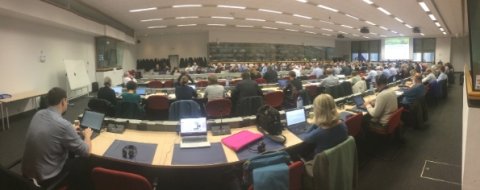Report by Gerry Lawson
On 25th February Gerry Lawson and Josep Crous Duran represented EURAF at a meeting with the above title, which included members of the “Environment and Climate Change CIvil Dialogue Group” and national delegates on the “Expert Group for Horizontal Questions Concerning the CAP”. With these meetings the European commission wants to establish a regular dialogue with non-governmental organizations, socioeconomic interest groups, civil society organizations.
Keynote addresses were given by Jerzy Plewa (DIrector General for Agriculture, Maurio Petriccione DG for Climate and Daniel Calleja-Crespo DG for Environment). It was gratifying that all three mentioned the potential importance of agroforestry.
Plewa emphasised that the Strategic Plans of Member States (MS) must fully integrate environmental regulations and the 40% threshold for spend on environment and climate issues. There was a common for the strategic plans, including a) enhanced conditionality and the new GAEC conditions, b) ecoschemes within PIllar I, agri-environment-climate payments in Pillar II. GAEC rules would be defined by MS with level a playing field across MS. He highlighted GAEC5, the “farm sustainability tool (FAST) and a “bottom up” approach to incentives which were targeted on specific issues. MS may decide to support specific types of farming practice and this “will be a game changer across the EU”. The CAP will continue to fund Knowledge Transfer, Innovation and Cooperation. Agroforestry mentioned as a Pillar II measure with potential for soil conservation.
Petriccione emphasised that DG AGRI, CLIMA and ENVI work closely together. Agriculture, Forestry and Other Land (AFOLU) use has a crucial role in mitigating and adapting to climate change and in limiting the temperature rise to 1.5C. Key EU initiatives are the LULUCF Regulation and Climate Change Long Term Strategy, and the Bioeconomy Strategy . National Energy and Climate Plans are planned for all MS, and initial drafts have been finished. He stressed that “Coherent and ambitious policy making needs accurate and reliable data are crucial for planning, with the IACS/LPIS system very important for farmers. Parcel level data on land use is invaluable for monitoring climate policy and there is an important synergy between climate and agricultural data. Farmers can use different techniques to reduce emissions and move from a “compensation for additional costs’ to a reward for “reward for services provided”. He made specific mention of agroforestry as one of the most promising methods to reduce net emissions and stress the importance of result-based databases, although there are many monitoring challenges. The LIFE programme has funds to test results based systems. Farmers should embrace the opportunities and MS should write ambitious strategic plans.
Calleja-Crespo stressed declining biodiversity, environmental quality and felt that unsustainable farming eas reaching alarming levels. Yet win-win solutions do exist for farmers, environment and society; and he specifically mentioned agroforestry and organic farming. Air pollution causes crop losses of up to 3 million euros per year, and biodiversity could be much enhanced by flower strips to favour pollinators. Treatment of nitrate pollution is a major cost in northern Europe and the Commission has proposed minimum requirements for water reuse. CAP reform is an opportunity to introduce solutions with: a) enhanced environment and climate performance, b) improved links between CAP and environmental legislation, c) inputs by environmental authorities to CAP Strategic Plans, d) introduction of results-bases schemes An important feature is the alignment with Natural 2000, national air pollution targets, water framework directive, codes of good practice in the nitrates directive. The CAP should focus on breaking down SILOS between different policies, pillars and administrations. Performance and results based policies should bring land users together with the experts.
Discussions continued through the day and will be reported in a further document. EURAF delegates pointed out that “results based payments” could be made to work for GHG and nitrogen abatement if existing GIS-based farm-sustainability models (e.g. GAEC5) were modified to include the role of trees on farms, and if both farmers and payments agencies were brought on-side to collect the data necessary for validation.












